Neverwinter Nights Updated Preview
We brave the frigid Edmonton tundra to bring you new impressions of this anticipated RPG.
Interview
The lounge at BioWare looks just how you'd imagine a developer's rec room. In addition to the foosball tables, blue-felt pool table, and coin-ops, a large wooden table holds just about every gaming console you can imagine. Xbox, PlayStation 2, and GameCube games are stacked on the shelves and strewn on the table. But even with all this cutting-edge technology around, BioWare's Chris Christou and Tom Ohle are engaged in a heated match of NHL 96 on the Sega Genesis. "Reee-diculous," Ohle says as he misses a shot. Greg Zeschuk, cofounder of BioWare, thumbs through a black binder, holding pages and pages of notes. It's the company's NHL 96 tournament record. "It's pretty nerdy," Zeschuk says.

This statement is ironic, considering BioWare's excellent Baldur's Gate games have made the company synonymous with the nerdiest of licenses, Dungeons & Dragons. But the scene bodes well for the rest of the day--a handful of people are here to play BioWare's highly anticipated Neverwinter Nights. As indicated by their obsession with NHL 96, the employees of BioWare are clearly more concerned with gameplay than flash. This theory is confirmed for the remainder of the visit, as we explored a limited amount of the single-player campaign, participated in a demonstration of the multiplayer options, and fiddled with the robust toolset, which lets you create your own modules and campaigns.
Neverwinter Nights begins in the city of Neverwinter. Your character is a recent graduate of the city's prestigious academy, run by the esteemed paladin Aribeth de Tylmarande. All is not right in Neverwinter, but the students, secluded in the fortress of the academy, have experienced nothing but rumors about the trouble brewing outside the walls.
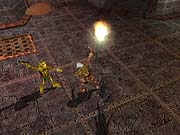
You begin in the academy, and talking with the teachers and fellow students acts as a tutorial. You'll be introduced to trading with shopkeepers and conversing with nonplayer characters. Conversations follow your typical dialogue trees, with different options for responding based on your characters' intelligence and skills. Melee characters go through brief introductions to the ranged and close combat systems, while spellcasters learn the basics of casting. The interface is quick to learn: simply click on a character or object, and a circular menu will appear, allowing you to attack, cast a spell, or converse. A wide variety of hotkeys and shortcuts give you plenty of additional options for interacting with the world around you.
The tutorial comes in handy quickly. It's not long before the problems of Neverwinter come crashing through the academy walls, with strange creatures occupying the hallways. You'll fight your way to an initial encounter with Aribeth, who confirms the rumors you've heard as a student: Neverwinter is victim to a terrible plague, the Wailing Death, and the city's healers are helpless against it. A cure is being devised from a group of rare Waterdhavian creatures, and Aribeth charges you with finding and protecting them from the interlopers.
Soon you'll be out on the streets of Neverwinter, and it's here that the game really begins. The moment you leave the academy, you are beset by the harried citizens, asking you for all sorts of help. A prison break has caused one sector of the city to be overrun with ruffians and bandits. Another sector has been overrun by the undead. We were given a few hours with the single-player game, and we barely made a dent in the first chapter. Putting an end to the plague and those who want it to continue is the primary story, but it's clear that Neverwinter Nights gives you plenty of side quests to keep your character occupied and leveling up.
Character Creation
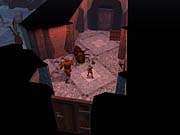
The character-creation system is robust, and Neverwinter Nights uses almost all of the 3rd Edition Dungeons & Dragons rules. You can create a character from scratch, choose one of the premade character kits, or choose a basic template and take the recommended statistics, skills, and feats. One of the best new features of the 3rd Edition rules are these skills and feats, which make for much better rewards when you gain levels. Gone are the abstract benefits of leveling from previous editions--now you'll get to assign skill points in a wide variety of areas, including weapon proficiencies, picking locks, or being able to identify spells as they are cast. Feats act as special abilities, allowing you to attack several enemies at once, access better armor types, or successfully cast in hostile conditions. These additions make it possible to create more varied characters: You can be a plate-mail-wearing spellcaster or a spellcasting warrior, depending on the skills and feats you choose.
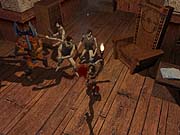
Neverwinter Nights seems to make good use of these additions, and it does so in a way that is almost invisible to the user. Dialogue trees let you access your intimidation and persuasion skills. Choose the cleave feat, which lets you attack a second opponent after making a killing blow, and your character will do so automatically, with a rewarding little "cleave" message appearing over your second victim. Other abilities require you to take a more active role. We tried a bit of the prologue as a monk, whose stunning fist and flurry of blows abilities must be selected before targeting an opponent. We also tried the druid, sorcerer, wizard, paladin, and barbarian classes, and all seemed to correspond nicely with their pen-and-paper counterparts.
Activating the abilities is easy. There is a handy hotkey bar running across the bottom part of the screen, allowing you to assign skills, spells, feats, and inventory items to the 12 function keys of the keyboard. Add Shift and Ctrl, and you have a total of 36 hotkeys at your disposal, giving easy access to almost anything you'll need in the heat of battle.
Combat takes place in real time, though you can pause to assign orders, as in the Baldur's Gate games. Such action is less necessary in Neverwinter Nights, because you primarily control a single character. You can hire a single henchman to join your cause, and spellcasters can summon familiars and charm monsters. The lack of a traditional party calls to mind Diablo II, though with a much more complex set of rules taking place behind the scenes. Also similar to Diablo II is the game's teleportation system--it's easy to return to the academy to sell loot. You'll also return to the academy if you die, and it's a quick return trip to the point of your demise.
There are two reasons behind the decision to focus on a single character. One reason is that BioWare wanted to focus on a single character's ascent from a lowly acolyte to a powerful hero. Neverwinter Nights lets your character reach the 20th level, currently the highest level attainable under 3rd Edition rules (though most players will need to reach only the teen levels to complete the game). More importantly, though, the single-character focus makes the single-player game more congruous with the multiplayer game.
Mastering the Dungeon
Much has been written about the plans to make Neverwinter Nights a means of running Dungeons & Dragons campaigns, and we were given a brief run-through of the highly anticipated Dungeon Master utilities. In the right hands, these tools will be excellent. Running a campaign uses an interface very similar to the single-player campaign. As the Dungeon Master, you act as an invisible player in the world. Click on an NPC to take control, converse with the players, and then send them on their way. Drop monsters, NPCs, and shopkeepers into the game on the fly and add pertinent items to the hotkey bar for instant access.
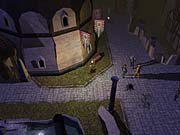
We were given a demonstration of how the tools are used with a short campaign led by BioWare's Trent Oster, Tom Ohle, and Jay Watamaniuk. The players began in a tavern, where the barkeep explained that there were some problems in the town. His responses were a mix of pre-scripted statements and live chat by the Dungeon Master. He didn't know much, so he sent the players out for more information, and the process continued into the forest and finally to a wilderness mountainside. Once the evil was dismissed, a powerful spellcaster teleported the players to a safe spot for their reward. It was simple and direct, but it showed just how powerful these tools can be with a talented dungeon master.
Running the campaign is just part of the process. Before bringing players into your world, you'll have to create your world, and you can set up most of your campaign before it begins using the Aurora toolset. And, in our brief experience, the toolset was the most impressive feature of Neverwinter Nights. This toolset is made up of "wizards," menus that let you create maps, items, monsters, and NPCs in just a few steps. You begin with the area wizard, which lets you create the basic map of a zone. Choose a map size, choose a landscape, and just start laying down the visual element of your world. Raise and lower the elevation in outdoor areas, add pits and bridges, adjust the lighting and weather conditions, and decorate the landscape with scenic elements. It's easy and fast.
To add an NPC to your world, you just choose a character or monster type, select some basic attributes, change its appearance if you like, and then begin creating the dialogue tree. You just click and type, and you can set special parameters for the characters' responses. Want your NPC to give a special item to any male dwarves in the party? Have some information that will go to only charismatic female characters? Click a few boxes, and it's done.
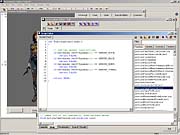
Creating special items is just as easy. Choose the type of item and add any attributes you like. You can create incredibly powerful weapons and items--in the demonstration, we made a bastard sword that did additional electrical damage. What's great about the toolset is that it lets you jump into the game and see your creations, and we were able to quickly start up our custom maps and see characters picking up and wielding the sword, crackling with power. You can add static monsters or random encounters to your maps. For random encounters, you set a trigger point and then choose spawn points for the creatures. You can choose a difficulty level, and the game will automatically adjust the creatures' statistics for the party. This macromanagement is one of the most exciting things about the Aurora toolset--it lets you have as much control over your campaign as you'd like. You can create uberdragons or orc armies to challenge your players or simply let the engine create appropriate encounters when needed.
Nonplayer character attitudes are handled in a similarly universal way. You can have players' actions change their standing with different factions, and NPCs and creatures can be grouped in factions and respond to players accordingly. While there is a fair amount to learn so that you can use the tools effectively, the interface is relatively simple and features most everything you'll need to build a single- or multiplayer campaign. The Aurora tools let even luddite designers create epic, branching adventures with only a modest time investment required to learn the ins and outs.
And though BioWare may be concerned with gameplay instead of flash, Neverwinter Nights features some impressive visual effects. The lighting effects were especially noteworthy, with long, realistic shadows being cast from players' torches. The spell effects looked good as well, especially the powerful weird, which summons a horrific creature that rises from the ground and does significant damage to anything in its reach.
Neverwinter Nights is arguably the most anticipated game of the year. There are countless fan sites, as well as an army of dedicated zealots following the game's every move. The company has certainly earned it, with two hugely successful Dungeons & Dragons-based games to its credit and an ambitious design for its next. It's attempting to create both a solid single-player game and a multiplayer game that will have a life span limited only by the creativity of its users. And from our brief experience, it's poised to succeed on both fronts.
Got a news tip or want to contact us directly? Email news@gamespot.com
Join the conversation